An Air-conditioner with heat isn’t the only thing that you can hang on your wall to keep you warm. A more convenient and hassle-free option would be to look for the “little brother” of the AC. Check out the piece we have prepared for you and become familiar with how to pick one of the best electric wall heaters on the market.
In our comprehensive electric wall heaters reviews and guide, you will quickly find out that a wall heater will save you space, money, and time. It will give you enough heat to keep you happy and warm but without the gruesome installation ordeal and maintenance costs.
We have divided our article into sections where you will see our handpicked choices, some pros & cons as well as comparisons.
See The Quick Comparison Chart
Why You Should Buy a Wall Heater
A wall heater doesn’t have to be the primary heating device in your house in order for it to be useful. What it does is provide you with some warmth and it does it fairly quickly. Such a gadget needs around 2-3 minutes to start radiating heat and depending on the model, it might also include a fan. This is a common feature of most top brands on the electric wall heater market.
Quickness Is a Convenience
So quickness is definitely one of the major upsides of a wall heater. You don’t want your heater to start wasting all this electricity and give off warmth only after 10-15 minutes. The portability of this device allows it to start functioning quickly and it yields fantastic results.
It is great when you want to heat just one room or several rooms separately. Smaller homes typically do not have central heating. What you can do is maybe buy 1-2 of these wall heaters and distribute them around the premises of your home.
Temperature Control
If you could get some electric wall heaters with thermostat then you even do not have to monitor the temperature yourself. The temperature control is automatic and most products will feature just a button or two. So in other words, simplicity and functionality go hand in hand when we talk about wall-mounted electrical heaters. Some more complicated and advanced devices might also include:
- ALCI plug (for bathroom use)
- Digital display
- Manual thermostat
Don’t Get Crowded
One of the most distinguished and unique qualities of wall heaters is that they will save you plenty of space. The floor has only this much square footage and you cannot put countless things on it. Furnishing is demanding enough and often times there’s not enough room for a heater.
Attaching it to a wall will basically turn the electric heater into a picture or a poster. The best part is that people will rarely notice it as it truly blends in with your environment. Take advantage of your floor space fully by obtaining a wall heater.
Detaching And Installation Are Not Challenging
Mounting the gadget onto a wall or removing it afterward is also not something that is very challenging. There are those models that require a cutout in the wall to be made initially. When it comes to them, a DIY installation might not be the brightest idea. Still, such heaters aren’t hard to mount but they definitely require some knowledge and proper tools. If you aren’t sure how to exactly cut a hole in the wall and connect all the wirings, then look for a professional.
The same goes for when it is time to remove an electric wall heater. It is especially important to have professional help when detaching the wiring. There’s an electrocution hazard when doing this and it can threaten your life if you aren’t careful. Again, all of these procedures are rather simple when you know exactly what you’re doing.
Warmth Stays
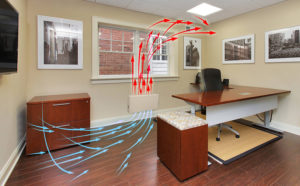
Convection allows the room to get warm evenly. This also allows the heat to remain there even after you plug the heater off. Yes, it takes longer for the temperature to rise but it doesn’t go down as easily as well.
Another reason is the body of the wall heater. Some panel heaters are made of aluminum or specialized steel only to retain as much heat as possible. The metal body of the device stays warm and keeps radiating heat even after the flow of electricity stops.
Downsides of Wall Heaters
There aren’t many disadvantages that we are going to outline here but we still have to mention a few in order to really call this guide a complete one. These drawbacks are really not deal breakers but you should keep them in mind before swiping your credit card.
They Cannot Be Your Primary Home Heaters
A regular wall heater will hardly solve all of your heating needs during the winter. Yes, if you live alone in a dorm such a device might suffice but a family of four will need more than that. A wall heater is a great addition and it is nice to have it playing the role of a complementary heater but not a primary one.
It just isn’t that powerful and even though there is some efficiency related to it, the amount of heat provided is not going to be outstanding.
Wall Heaters Are Stationary
You can’t move them. Once you attach them to your wall you will need to also take out the whole frame if you want to install the heater somewhere else. Not to mention that the ones which require a cutout in the wall are practically impossible to relocate.
Once you put a wall heater somewhere it sort of becomes part of the infrastructure of your home. The lack of mobility is definitely a drawback as electric radiators or floor heaters are easy to move from room to room.
Electric Connections Are Tricky
Depending on how you want your wall heater to turn on and off, you will need to decide on the connection. If you install it during a renovation then you will have the opportunity of having a separate switch especially for it.
Otherwise, you might have to connect it to one of the light switches. This means that there will be a dependency between your domestic lighting and the wall heater. Every time one is turned on, the other one will also be operational and vice versa.
Best Electric Wall Heaters Comparison Chart
| PRODUCT | DETAILS | ||
|---|---|---|---|
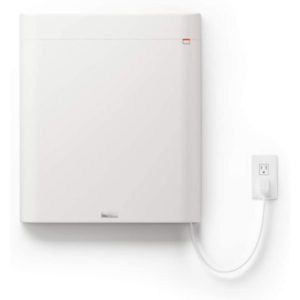 | Envi High-Efficiency Whole Room 120v Plug-In Electric Panel Wall Heater |
| View On Amazon |
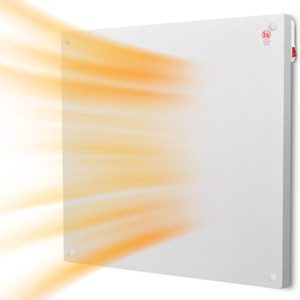 | Air Choice Heater Panel |
| View On Amazon |
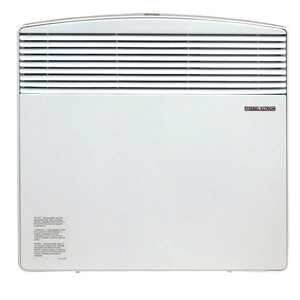 | Stiebel Eltron Wall Mounted Convection Heater |
| View On Amazon |
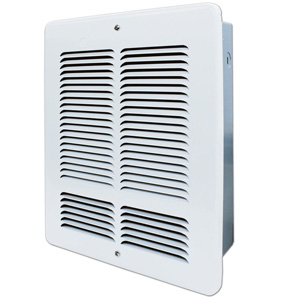 | King Electric Wall Heater |
| View On Amazon |
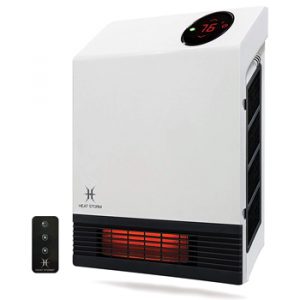 | Heat Storm Deluxe Indoor Infrared Wall Heater |
| View On Amazon |
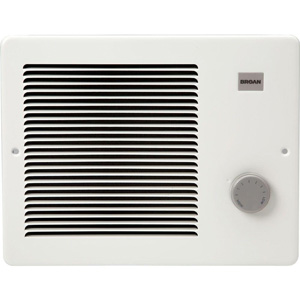 | Broan 174 Wall Heater |
| View On Amazon |
Best Electric Wall Heaters (Top List)
1. Envi High-Efficiency Whole Room 120v Plug-In Electric Panel Wall Heater
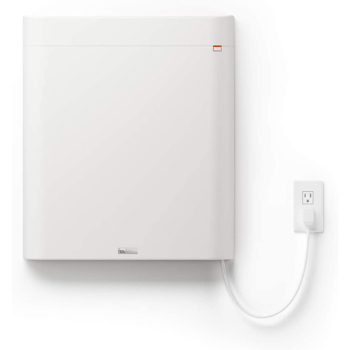
Beautifully designed to blend with the wall and with the ability to heat up to 150 sq. ft. It is powerful and efficient enough to warm up an even larger space, but that depends on the insulation.
There is no fan to blow dust around or make noise. Heating is done based on natural convection. Its power cord is 6 feet long, and there is a special compartment inside the heater where you can tuck away any excess cord length.
Safety is not neglected. The heating panel is suitable for all types of unconventional and mobile homes. It is safe to the touch because the front panel only gets slightly warm, not exceeding 90 degrees. If there is a power outage, the Envy Heater will shut down and start working automatically when power returns. Mounting it on the wall also protects children and pets.
The thermostat adds to the high efficiency, but if you want to up your game, even more, you can use a smart plug. Just make sure it has a capacity of at least five amps.
2. Air Choice Heater Panel
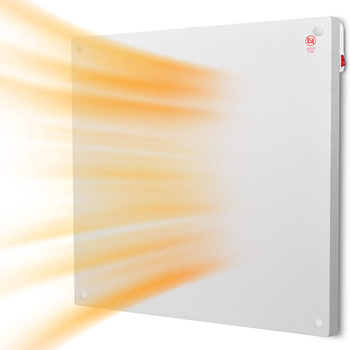
A nice little perk is the possibility to paint the heater in a color of your choice. Better yet, change the color from time to time to match your mood.
It is wall-mounted and needs at least two feet unobstructed space in front of it and one foot above the ground. The heating panel automatically starts operating after a power outage and has overheat protection. Using a simple 110 outlet, plug in the six-foot-long cord, and you will have a warm area of up to 200sq. ft. within 10 minutes.
With low consumption and constant convection heating, it is not only energy efficient but also cost reducing. Drawing 3.2A with its 400 watts, the panel circulates airflow upward and performs convection. Therefore, the ceiling installment is not advisory.
There is no need for a heat shield because the heat is absorbed into the wall, and you can also use it if your walls are laminated.
The safety warning stickers might cause some trouble when trying to remove them.
3. Stiebel Eltron Wall Mounted Convection Heater

The maximum temperature which the heater will give you is 86 degrees. However, this temperature is achieved at the expense of only 1000W making the unit a pretty efficient one. The product does not feature a fan but it is really not that much needed. Since heating is achieved through convection, you will still enjoy warm premises for extended periods of time. The only thing is that heating up typically takes a little longer. It weighs just under 10 lb.
4. King Electric Wall Heater

The maximum power output you can get is 1500W. The craftsmanship of this wall heater is truly impressive. It features an aluminum fan and a beautiful white front panel. In fact, the whole design and functionality are patented and it is called Smart Limit Technology. As you place your order, you will also be asked to choose between a 1-Pole and a 2-Pole Thermostat. In short, you see that versatility is the main property of this wall heater. A little drawback is that the product cannot be installed vertically on a ceiling but this possibility is rarely sought for.
5. Heat Storm Deluxe Indoor Infrared Wall Heater
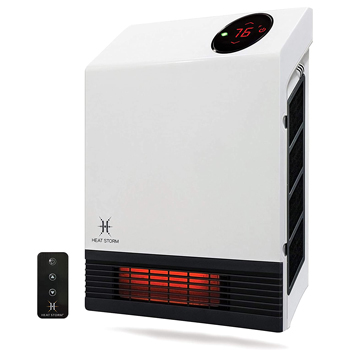
Not only that it is a compact appliance, easy to clean and efficient, but it also comes with remote control. Ultimately, your convenience is taken care of. You can also use the LED display on top in order to control the temperature or program the timer.
However, upon a power outage, you will need to restart it manually as it won’t remember the settings. Thanks to the Cool Touch feature, the unit will never get too hot to be touched by a family member. The presence of the fan will definitely boost the heating capabilities of the heater. Comes with a 1-year warranty.
6. Broan 174 Wall Heater

The front panel grill is also designed in such a way that it blows the hot air downwards. It is made out of heavy 20-gauge steel which will give you warmth for longer. There is only one dial for you to operate and it sets the temperature from “high” to “low”. The motor is permanently lubricated. This is a huge advantage as you won’t need to regularly unmount and take apart your wall heater for maintenance. You do not need to install it in a cutout in the wall. Surface mounting is also an option.
Electric Wall Heaters vs Air Conditioners
Most things related to domestic heating are all about preference but money definitely also matters. However, we cannot skip talking about other aspects of these two heating devices. Here’s what our research and common use show us.
Space
In terms of space, the wall heater definitely wins. These machines are smaller than an air-conditioner and they are not as bulky. True, some panel heaters are just big squares basically, but their body is rather slim.
That’s not the case with an AC. It possesses a longer rectangular shape and even has an outside unit. The outside unit makes noises and water leaks from it. It will take up space on your porch if you have one and you will constantly need to go out and wipe some water off the surface.
A little downside of the wall heater is that you should have any furniture near it. You should have at least 3 feet of distance between your heater and upholstered units or electrical devices. After all, safety always comes first. The AC won’t give you such spatial limitations.
Maximum Output
Without a doubt, an Air- Conditioner is significantly stronger in terms of power. Wall heaters will rarely give you anything more than 1500W. The amount of heat and the speed by which it is provided is in favor of the AC.
Expense
Now, this is where the wall heater really shines. It is a device that will give you nice, efficient heating options. Both the initial sum and the monthly electrical bills that you will pay should be lower than using an AC.
The initial sum that you have to pay for an air-conditioner with heating is at least 6-7 times bigger than what you will pay for a wall heater. It is believed that over an extended period of time this initial investment is worth it because of the “efficient heat” that you get from your AC. In short, people suggest that you will end up paying less for electricity and this is why spending $700 on an AC is alright.
This statement is somewhat wrong because you will struggle to find a significant difference in favor of the AC when it comes to your monthly electrical bills. A wall heater works at lower wattage but still gives off a fairly decent amount of heat. Thanks to this property, even if you pay 10% more monthly for electricity in comparison to using an AC, you will still save more money because of the retail price difference between the two.
Installation & Maintenance
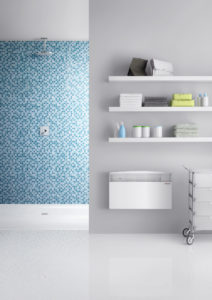
To make matters worse, you also need to have an outer unit attached in front of the room in question. The two units are interconnected and this means a hole in the wall needs to be drilled for the connecting tube. Typically a stand is also required for the outside unit along with noise-reducing rubber tips. You need to be prepared to pay an additional 10% of the price of the AC for installation.
You do not have such hassles when we talk about installing wall-mounted space heaters. Mounting this device can be considered to be a DIY project as it requires a screwdriver and elementary knowledge in electrical connections.
Now when we talk about a complete wall-mounted heater which requires being built-in the wall, you should, of course, get a handyman.
Maintenance is also tougher if you possess an air-conditioner. Not to mention that it requires annual checks by technicians. There are certain parts that require changing and that will force you into additional expenses.
By opting for a wall heater you basically have no further headaches related to changing any parts. As long as you clean the electric wall heater and make sure it doesn‘t short circuit, you will be all set. Dust it once in a while and make sure it doesn’t interact with any water or upholstery. Yes, that’s it – not very hard, right?
Operation
What an AC does is take the outside temperature and then invert it to the one you want indoors. This is why the outside unit blows cold air and the indoor unit spreads heat. However, this comes at the cost of a lot of energy. Yes, you will enjoy a decent temperature in your house and it will be tailored to your liking.
However, an AC constantly blows the air around. Many people find this to be rather inconvenient as a non-stop draft has a number of negative aspects to it. More often than not, it can turn out to be detrimental to one’s health.
If you check out our wall mounted convection heater reviews above you will quickly find out that the principle of operation is totally different from the one an air-conditioner has. Convection heaters will warm up a room gradually and evenly. While you might need to wait just a little bit longer than other typical electric radiant floor heaters, you will be happy with the results.
Furthermore, once you turn off an AC, you are losing all hope of retaining any warmth. The aluminum body of a wall heater gives you residual heat.
The Most Common Properties of a Wall Heater
Now that we have seen all the advantages and disadvantages of electric wall heaters it is time to outline their most important characteristics. You will notice that some aspects are pretty much the same as most energy-efficient space heaters but there are some niche features inherent only to energy-saving wall heaters.
Size and Dimensions
Thickness rarely matters when we talk about wall heaters. Their bodies are usually slim and that means that the only dimensions you should be careful about are width and height. The models which require being built-in the wall are the exclusion to this rule because you need to know how deep it needs to go in the wall.
You should also plan your furnishing accordingly. That’s because nothing should interact with the heater or be close to it than 3 feet. This is rather important as otherwise, you will have some safety risks. Another aspect as to why dimensions matter is related to your wall decorations. You don’t want to have just the heater there on an empty wall. Make sure you have some decoration around it but make sure everything is in compliance with the safety instructions.
Power output and functions
When you take a look at most heating and cooling systems out there you will definitely notice some similarities in energy consumption. That doesn’t mean that you should just rush and get the first available product.
Think about the size of your room. The larger it is, the stronger the wall heater you will need. A 2000W one is pointless in a 100 square feet room. In this case, you should aim at getting something smaller which will end up using very little electricity and will still provide you with a lot of heat.
Check how many different power output settings you have. The best wall heaters will have at least two – high and low. Some other products directly have degrees written on the dial. They rarely let you know anything about the wattage but give you a certain temperature depending on the setting.
Another popular function is the timer. It is a convenience that shouldn’t be neglected. Yes, you will likely have to pay a little bit more than average for such a wall-mounted heater but it is completely worth it. A timer gives you more control and lets you sort of forget about the wall heater.
The Effect of the Design
The design is usually directly linked to the way a wall heater functions. Some of them feature infrared technology and others are efficient space heaters. The composition determines the functionality to an extent.
The simpler metal wall heaters feature a clean design with very few things and dials on the panel. This way the whole body gets heated and when you turn them off you get heat for extended periods of time.
Thermostat Matters, Or Does It?
It is not 100% obligatory for a wall heater to have a thermostat dial. Most products will have that component built-in. This means that your interference is not required in order for the wall heater to shut down after reaching a certain temperature.
In other cases, you will have a dial on the front panel allowing you to set the temperature or at least the intensity at which the device will shut off. Many people find this the more convenient option as it gives you total control over the duration of which the wall heater works.
It’s Nice to Have a Fan
Who doesn’t like a machine which blows hot air around during winter nights? A fan will definitely make a difference as the feel of warmth will be easily spread around the room. Furthermore, it will feel like the temperature is higher than it actually is.
If you can live with the slight noise, then get a wall heater with a fan. You can even dry clothes around it or even deal with unwanted moisture on the ceiling. Just know that it might increase the electrical usage of your heater.
Wrapping Up
This brings us to the end of the buying guide we prepared for you on the topic of the best wall heaters. We believe we have highlighted all the important elements of getting the most suitable product for your needs. Please feel free to point out any aspects that we might have overlooked in our electric wall heater reviews post.
If you think our research was useful and sufficient please comment and share the article. Go through the whole thing again if you want to be reminded of certain details and only after that, buy the heater you like the most.
Read our other guides on heaters such as our kerosene heater reviews or propane heater reviews as well and as always – stay put!

Leave a Reply